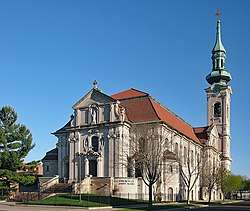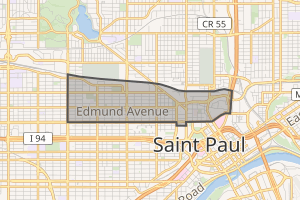Frogtown, Saint Paul
Frogtown is a neighborhood in Saint Paul in the U.S. state of Minnesota. Built around University Avenue, the Thomas-Dale neighborhood is colloquially known as Frogtown (originally "Fracht-town", a German neighborhood where many railway workers lived, "Fracht" being the German word for "freight"). Historically, Frogtown was a subsection of the current Thomas-Dale neighborhood. It is bordered by University Avenue on the south, the Burlington Northern Railroad tracks to the north, Lexington Parkway on the west and Rice Street on the east.[3]
Thomas-Dale | |
|---|---|
 The Church of St. Agnes, which is prominently visible in the center of the neighborhood. | |
| Nickname(s): Frogtown | |

| |
| Country | United States |
| State | Minnesota |
| County | Ramsey |
| City | Saint Paul |
| Area | |
| • Total | 1.714 sq mi (4.44 km2) |
| Population (2010)[2] | |
| • Total | 17,049 |
| • Density | 9,900/sq mi (3,800/km2) |
| Time zone | UTC-6 (CST) |
| • Summer (DST) | UTC-5 (CDT) |
| ZIP code | 55101, 55103, 55104 |
| Area code(s) | 651 |
| Website | http://www.frogtownmn.org/ |
Early settlement
The neighborhood was first settled 1860–1880 as the downtown area outgrew its borders. Workers on the St. Paul and Pacific Railroad, now BNSF Railway, which was built just to the north of the neighborhood sought housing nearby. Minnesota's first successful locomotive run occurred on these tracks in 1882. Shortly thereafter the Jackson Street Railroad Shops were built just northeast of Frogtown. The Jackson Street Shops were then joined by other railroad related industries in the area including the Saint Paul Foundry, built near Como and Western Avenues, providing additional employment opportunities for residents.[3]
Residential development moved westward through the neighborhood as Polish, Scandinavian, German, and Irish immigrants took blue-collar jobs in the area. They built modest wood frame and brick houses on small lots in the neighborhood. Urban renewal has wiped out many of these homes, but working-class Victorian homes from the 1880s are extant, some adorned with arched window and door openings, brick window hoods, and frilly intact open porches.
Commerce
Commercial buildings lined University Avenue as street cars along the corridor were able to efficiently transport workers to employers. The line also became the first intercity street car line, connecting Minneapolis with Saint Paul in 1890.[3]
Today

Today many view Frogtown as a new enclave for Vietnamese and now Hmong immigrants, who, in Saint Paul, comprise the largest urban contingent in the United States.[3][4] Amenities include a full-service bank, gas station, community medical clinic, family services organizations, two parks, several Asian supermarkets, a traditional butcher shop, several convenience stores, the historic No.18 Fire Station.
A profusion of immigrant-owned businesses line University Avenue, offering clothing, shoes, jewelry, household items, entertainment media (DVDs, CDs, video games) and groceries. Immigrants from Africa operate several Halal meat markets in the area, which also offer traditional African breads, spices and foodstuffs. Mexican-American immigrants operate small traditional Mexican carnicerías. The avenue is dotted with restaurants serving Cambodian, Thai, Laotian, Hmong, Vietnamese, Chinese-American and Mexican cuisine, some of it very authentic. A notable local barbecue sells Southern-style barbecued pork ribs, beef ribs and chicken at their location near the northwest corner of University Avenue and Dale Street.
Transportation
The METRO Green Line light rail, which opened on June 14, 2014, serves the neighborhood with stops on University Avenue at Victoria Street, Dale Street, and Western Avenue.[5]
Education
St. Paul Public Schools serves Frogtown.[3] Some residents are zoned to Jackson Elementary, while some are zoned to Galtier Elementary.[6] Some residents are zoned to Ramsey Middle, and some are zoned to Washington Middle.[7] Some residents are zoned to Central High School, and some are zoned to Como Park High School.[8]
The Catholic parish of St. Agnes also serves the area of Frogtown with its comprehensive elementary and high school, classes of kindergarten through senior high school.
Saint Paul Public Library operates the Rondo Community Library adjacent to Frogtown.[9] The newly renovated Rondo Library opened in late August 2006.
References
- "Thomas-Dale neighborhood in Saint Paul, Minnesota (MN) detailed profile". City-Data. 2013. Retrieved 2017-03-08.
- "Saint Paul Neighborhood Profile: Thomas-Dale". Minnesota Compass. October 2011. Retrieved 2017-03-08.
- "Frog Town or Thomas Dale". Ramsey County Historical Society. 2005. Archived from the original on 2008-04-11. Retrieved 2008-07-22.
- Tom Kenworthy (2004-11-29). "Hmong get closer look since shootings". USA Today.
- "Three stations added to Central Corridor LRT Line". Metropolitan Council. January 25, 2010. Archived from the original on June 13, 2010.
- "Saint Paul Elementary Schools" Map. Saint Paul Public Schools. Retrieved on March 27, 2010.
- "Saint Paul Middle Schools Archived July 24, 2011, at the Wayback Machine" Map. Saint Paul Public Schools. Retrieved on March 27, 2010.
- "Saint Paul High Schools Archived July 24, 2011, at the Wayback Machine" Map. Saint Paul Public Schools. Retrieved on March 27, 2010.
- "Rondo Community Outreach Library Archived July 22, 2010, at the Wayback Machine." Saint Paul Public Library. Retrieved on March 27, 2010.